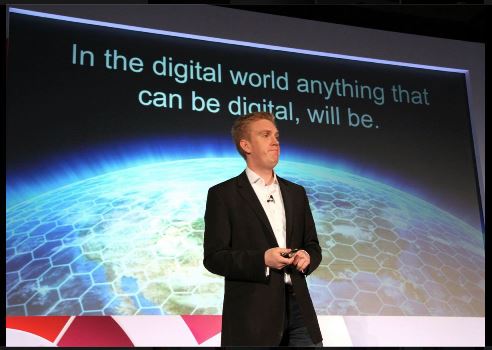The world lacks a building automation and control ontology.
|
November 2013 |
[an error occurred while processing this directive] |
|
Disruptive
Innovation makes Cloud Era Possible
The world lacks a building automation and control ontology.
|
| Articles |
| Interviews |
| Releases |
| New Products |
| Reviews |
| [an error occurred while processing this directive] |
| Editorial |
| Events |
| Sponsors |
| Site Search |
| Newsletters |
| [an error occurred while processing this directive] |
| Archives |
| Past Issues |
| Home |
| Editors |
| eDucation |
| [an error occurred while processing this directive] |
| Training |
| Links |
| Software |
| Subscribe |
| [an error occurred while processing this directive] |
We
are fast approaching the day when all of the sensors, actuators and
other assets attached to an Internet-connected building automation
network have a common way of communicating their name and location. The
global telecommunications industry is throwing its weight behind
the effort under the umbrella trade organization TM Forum, with
leadership from the Open Geospatial Consortium (OGC), for
location-service standards.
To date, controls professionals and their collaborating architects,
mechanical engineers, code officials, general contractors, building
owners, facilities operators etc. have not had a common naming
convention. Or, to put it in the words of computer scientists, the
world lacks a building automation and control ontology. Everyone
who services buildings would benefit from predefined and universally
understood device names and the equivalent of a GPS in every BACnet
controller. No one enjoys time spent lifting ceiling tiles and
testing connections to solve all the mysteries and errors in building
blueprints and control schematics.
Progress in bringing physical buildings into the digital world has been
severely hampered by the ontology void. Project Haystack, an open
source initiative within the building automation community, has brought
awareness to the problem and some progress through their efforts to
develop tagging conventions and taxonomies for building equipment and
operational data. This project augments the definitions for data
normalization, data use and communication for building controls that
can be found in internationally recognized and supported standards from
ASHRAE, ISO and IEC, such as ISO 61499. Yet, none of these
comprise an ontology. The telecommunications industry has now
identified the issue as one of the barriers to wider adoption of smart
grid, M2M networking and other services in the digital ecosystem.
A trade group for the Communications industry, TM Forum, is best known
for the Frameworx suite of best practices and standards. Craig
Bachmann, Director, Industry Initiatives, TM Forum says, “As we invest
in smart grid, M2M and digital health initiatives, integrating location
standards into Frameworx has become critical to our success.”
That's why TM Forum is engaging with the Open Geospatial Consortium
(OGC) to address location information issues.

TM Forum's Digital Disruption Keynote, Nik Willetts,
Chief Strategy Officer, TM Forum
Regarding the ontology, the combined forces of TM Forum's 900
communications-industry members and the 475 OGC member companies
(government agencies, research organizations, and universities) should
get the job done. With leadership from TM Forum and OGC, events like
last April’s BACnet Ontology Hackathon have taken place.
Four out of five global communication service providers have adopted
Frameworx. This has enabled the global Communications industry to move
ahead as a unified force, rapidly introducing the successive waves of
disruptive innovation that make today's Cloud Era possible. TM Forum is
now engaging with utilities around the world, exploring the possibility
of a Frameworx for the Smart Grid. A BACnet ontology would be a key
piece of this effort.
[an error occurred while processing this directive]One of the first public showings of TM Forum and OGC collaboration was
as part of the Smart Grid Catalyst Project, demo’ed at Digital Disruption 2013, October 28th-31st in San Jose. TM Forum accelerates
industry thinking by organizing such rapid collaborative projects among
member companies. Teams comprised of enterprises, service providers and
suppliers are given four months to work together to create
proof-of-concept solutions. Hydro-Quebec and BC Hydro were
co-champions of the project along with Cisco systems, with the
participation of BaseN, Infonova, and TOA Technologies and support from
Ericsson and Integrated
Architectures (IAI), leader of the Security
Fabric Alliance. Among the ten Catalyst Projects contending at this
event, the Smart Grid project won the "Most Innovative Catalyst" award.
BaseN’s VP, Product Management, Anders Viden explained, “Applying new
disruptive technologies and advanced networking models, utilities will
be able to interact with customers in a whole new dimension. This
Hydro-Quebec demonstration project focuses on how a digitally-enabled
utility can both be more responsive to customers and address
operational challenges.”
The OGC/TM Forum liaison should produce a consensus ontology soon - at
least for the physical location aspect of the problem. The naming of
topological locations is another issue, e.g. this sensor is downstream
to that air handler. The ontology experts will likely build upon work
like Project Haystack to crack this part of the problem.
About the Author
Therese
Sullivan, Principal, www.buildingcontext.me
Engaged in brand building, social media community organizing and
content creation for some great minds in building energy efficiency.
Led the awareness campaign for the IDeAs Z-squared facility, an
Integral Group net zero energy commercial project - one of the first in
the nation.
[an error occurred while processing this directive]
[Click Banner To Learn More]
[Home Page] [The Automator] [About] [Subscribe ] [Contact Us]